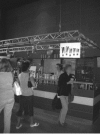View the label before you view the movie: a field experiment into the impact of portion size and Guideline Daily Amounts labelling on soft drinks in cinemas
- PMID: 21645373
- PMCID: PMC3121640
- DOI: 10.1186/1471-2458-11-438
View the label before you view the movie: a field experiment into the impact of portion size and Guideline Daily Amounts labelling on soft drinks in cinemas
Abstract
Background: Large soft drink sizes increase consumption, and thereby contribute to obesity. Portion size labelling may help consumers to select more appropriate food portions. This study aimed to assess the effectiveness of portion size and caloric Guidelines for Daily Amounts (GDA) labelling on consumers' portion size choices and consumption of regular soft drinks.
Methods: A field experiment that took place on two subsequent evenings in a Dutch cinema. Participants (n = 101) were asked to select one of five different portion sizes of a soft drink. Consumers were provided with either portion size and caloric GDA labelling (experimental condition) or with millilitre information (control condition).
Results: Labelling neither stimulated participants to choose small portion sizes (OR = .75, p = .61, CI: .25 - 2.25), nor did labelling dissuade participants to choose large portion sizes (OR = .51, p = .36, CI: .12 - 2.15).
Conclusions: Portion size and caloric GDA labelling were found to have no effect on soft drink intake. Further research among a larger group of participants combined with pricing strategies is required. The results of this study are relevant for the current public health debate on food labelling.
Figures
References
-
- Matthiessen J, Fagt S, Biltoft-Jensen A, Beck AM, Ovesen L. Size makes a difference. Public Health Nutr. 2003;6(1):65–72. - PubMed
-
- Steenhuis IHM, Leeuwis FH, Vermeer WM. Small, medium, large or supersize: trends in food portion sizes in The Netherlands. Public Health Nutr. 2009. pp. 852–857. - PubMed
Publication types
MeSH terms
LinkOut - more resources
Full Text Sources
Medical



